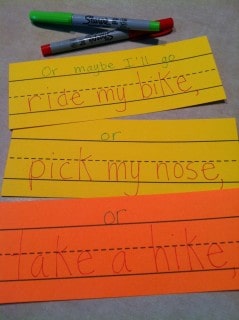Kids love to get up and get moving, which is great because movement can help reinforce learning. Most children also love games. Put movement and games together, and you have a high energy activity that can be done quietly in any classroom: Charades!

The following game of charades uses the twenty-seven activities found in the poem “I Don’t Know What to Do Today.” It’s simple to prepare, exciting, and teaches children that poetry is fun while helping them reinforce important skills like memorization, cooperation, and word association.
- Prepare the game cards: On note cards or slips of paper, write each “part” of the following poem. Use one color for any words that are not part of the action, such as “Maybe I’ll go” in the phrase “Maybe I’ll go ride my bike.” Use another color for the action phrases. This way the children can identify their action, but still be able to put together the entire poem at the end of the activity.Write the first line of the poem, “I don’t know what to do today,” and the last verse, “I’m so confused…” on their own cards to be used in the last part of the activity. Do not distribute these to the students.
- Write the poem on the black board, or distribute individual copies of the poem to students.
- Read the poem out loud together.
- Distribute the “game cards,” one to each student. Ask them to look at their card, then turn it upside down on their desk. It’s a secret!
- Explain the rules of charades:
- Tell them to use their body to act out the activity written on their card.
- NO talking!
- You may want to put a time limit on each turn.
- As one students acts out his or her card, the other students guess what they’re doing. Have the students raise their hands, and you (the’ teacher) can call on them. It’s best if they’re not shouting out answers.
- The student who is the first to guess the answer gets to go next. Once they’ve been a guesser and an actor, they may not guess any more.
- Once all the activities have been guessed, the game is over!
- Finally, line the children up in the correct order of the poem. You read the introductory line (adding your own “I don’t know” motion). Have the students recite their line of the poem while making their motion for the activity. When it gets to the end of the line, you can recite the final verse or choose a student to do so.
You can practice this a couple of times, and then record it and have the children watch themselves bring the poem to life!
I Don’t Know What to Do Today
I don’t know what to do today.
Perhaps I’ll go outside and play,
or stay indoors and watch TV,
or take a bath, or climb a tree.Or maybe I’ll go ride my bike,
or pick my nose, or take a hike,
or jump a rope, or scratch my head,
or play a game, or stay in bed,
or dance a jig, or pet the cat,
or drink some milk, or buy a hat,
or sing a song, or read a book,
or change my socks, or learn to cook,
or dig a hole, or eat a pear,
or call my friends, or brush my hair,
or hold my breath, or have a race,
or stand around and slap my face.I’m so confused, and bored, and blue,
to not know what I ought to do.
I guess that I should just ask you.
So, what do you think I should do?–Kenn Nesbitt






